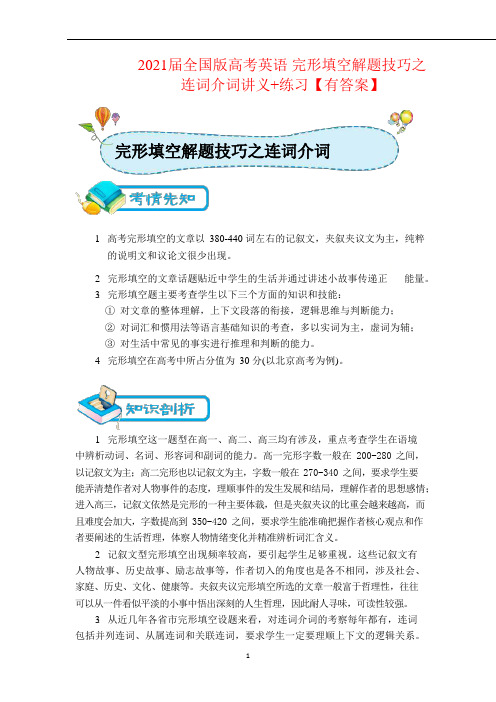[全国版][高三英语专题][第11讲 完形填空解题技巧之连词介词]讲义(教师版)
- 格式:docx
- 大小:1.10 MB
- 文档页数:17



【英语】完形填空中连词与介词题的快速定位之法1.完形填空中连词的选择连词一般用来表示原因、结果、让步、对照、补充、目的、条件等关系。
表示原因的连词:because, since, as, now that等;表示转折和让步的连词:but, though, although, whoever, whatever等;表示时间顺序的连词:when, while, as, after, before, since, until, as soon as, once等;表示目的的连词:so that, in order that等;表示条件的连词:if, supposing (that), unless, in case, so (as) long as等。
连词在高考完形填空题中考查的题目不是很多,一般是一两个。
对于连词的选择考生往往要注意前后句子之间的逻辑关系以及句子本身的结构。
例1 Some individuals find adventure in the simplest forms. For example, if you have never been out of your own country and you decide to tour Europe, guess what! You are engaging in adventurous activity! Conversely, some people consider adventure as something that increases the adrenalin (肾上腺素)and are not happy ______ they go skydiving or bungee jumping! Again, any form of adventure is good as long as the adventure travel pursued remains within the comfort zone of the individual.A. unlessB. sinceC. beforeD. because【解析】A。

2021届全国版高考英语 完形填空解题技巧之连词介词讲义+练习【有答案】1.高考完形填空的文章以 380-440 词左右的记叙文,夹叙夹议文为主,纯粹的说明文和议论文很少出现。
2.完形填空的文章话题贴近中学生的生活并通过讲述小故事传递正能量。
3.完形填空题主要考查学生以下三个方面的知识和技能: ① 对文章的整体理解,上下文段落的衔接,逻辑思维与判断能力; ② 对词汇和惯用法等语言基础知识的考查,多以实词为主,虚词为辅; ③ 对生活中常见的事实进行推理和判断的能力。
4.完形填空在高考中所占分值为 30 分(以北京高考为例)。
1.完形填空这一题型在高一、高二、高三均有涉及,重点考查学生在语境中辨析动词、名词、形容词和副词的能力。
高一完形字数一般在 200-280 之间,以记叙文为主;高二完形也以记叙文为主,字数一般在 270-340 之间,要求学生要能弄清楚作者对人物事件的态度,理顺事件的发生发展和结局,理解作者的思想感情;进入高三,记叙文依然是完形的一种主要体裁,但是夹叙夹议的比重会越来越高,而且难度会加大,字数提高到 350-420 之间,要求学生能准确把握作者核心观点和作者要阐述的生活哲理,体察人物情绪变化并精准辨析词汇含义。
2.记叙文型完形填空出现频率较高,要引起学生足够重视。
这些记叙文有人物故事、历史故事、励志故事等,作者切入的角度也是各不相同,涉及社会、家庭、历史、文化、健康等。
夹叙夹议完形填空所选的文章一般富于哲理性,往往可以从一件看似平淡的小事中悟出深刻的人生哲理,因此耐人寻味,可读性较强。
3.从近几年各省市完形填空设题来看,对连词介词的考察每年都有,连词包括并列连词、从属连词和关联连词,要求学生一定要理顺上下文的逻辑关系。
完形填空解题技巧之连词介词10 个完形高频词介词考察内容多,涵盖了初高中所学的介词所有用法,要求学生能够掌握与动词或名词等结合的搭配用法。
4.解答完形填空的总原则是“先完意,后完形”,即先理解文章的主旨大意和作者要传递的理念,再进行选择填空,在选择过程中需要综合运用以上技巧,以便得到更高的分数。

高考英语介词和连词的讲解(word版可编辑修改)编辑整理:尊敬的读者朋友们:这里是精品文档编辑中心,本文档内容是由我和我的同事精心编辑整理后发布的,发布之前我们对文中内容进行仔细校对,但是难免会有疏漏的地方,但是任然希望(高考英语介词和连词的讲解(word版可编辑修改))的内容能够给您的工作和学习带来便利。
同时也真诚的希望收到您的建议和反馈,这将是我们进步的源泉,前进的动力。
本文可编辑可修改,如果觉得对您有帮助请收藏以便随时查阅,最后祝您生活愉快业绩进步,以下为高考英语介词和连词的讲解(word版可编辑修改)的全部内容。
高考英语介词和连词介词是一种虚词,不能独立充当句子成分,需与动词、形容词、名词和代词等搭配,才能在句子中充当成分。
介词是用于名词或代词之前,表示词与词之间关系的词类,介词常与动词、形容词和名词搭配表示不同意义。
介词短语中介词后接名词、代词或可以替代名词的词(如:动名词v—ing)。
介词后的代词永远为宾格形式。
连词在句中的作用是把词与词、短语与短语、句子与句子连接起来。
它不能在句中单独作句子成分。
高考重点要求:1、介词的含义及在句中的作用。
2、介词+宾语构成短语的作用.3、介词短语在句子中的功能的理解。
4、并列连接词和从属连接词的使用和区别。
第一节知识点概述一、介词(一)表示时间的介词1。
表示时间段的介词(1)in , afterin +时间段,表示从现在起往后推算一段时间after +时间段,表示过去某时间往后推算一段时间,如:He’ll come back in two days。
但钟点用after( after three o’clock)He left on July 2 and returned after three days。
(2)in , during表示在一段特指的时间内,可用in 或duringThe work was done in / during the holidays。

高中英语高考复习资料--完形之语法、首尾呼应、固定搭配等解题技巧知识讲解及巩固练习题(含答案解析)题型介绍完形填空选项设置的几个特点1.同义、近义词辨析型,多倾向考查动词、名词、形容词。
平时要多把这几类词性的词归纳记忆。
2.固定搭配型多倾向考查动词和介词或副词、名词和介词、形容词和介词,典型句子结构的搭配。
3.常用语法(时态和语态、从句连词)。
4.根据上下文的逻辑关系确定选项型。
完形考查点1.以记叙文为主,内容涉及史实背景、风土人情、生活常识、经历体验等,要求考生有比较广的知识面。
2.连环题之间的连贯性、逻辑性强,应倍加注意。
解题技巧解题存在的主要问题1.简单地把所选答案代入空格,翻译;2.同义词用法的辨析不清;3.做题时的急躁或畏惧心理;平时的练习方法和提高途径良好的完形填空成绩主要表现在良好的阅读习惯和良好的语法功底,得阅读者得天下,完形填空也不例外。
培养自己良好的阅读习惯应做到:1.要以意群,语义为单位读,不要逐词逐句地认;2.要借助视觉扫读,不要手指唇动或无声心读;3.要从头至尾,一气呵成,不要频繁回读;4.要直接理解原文,不要逐词逐句地心译;5.要利用上下文和构词法猜测生词,推测出句意,不要频繁查阅词典;6.逐步扩大视距,要纵式快速阅读,不要横式赏析细读。
7.要有规律地做题,题不在多而在精。
每做一篇都要善于对比自己的思路和文章作者的思路,每做一篇都要总结自己失分的原因,并在下次做题时提醒自己不要再犯。
首尾呼应技巧首尾呼应是写作中的常用手法,高考中的完形填空短文尤其如此。
所以在做题时不但要考虑本句,还要考虑这个信息在文章的其他地方有没有相关信息。
语法技巧完形填空虽然以语境填空为主,但也有部分考查语法项目的题目。
对于这类题,可以利用平时所学的词汇知识,分析单词(词组)的使用范围、动词的及物不及物,并利用句子结构、句式特点等知识全面衡量所有选项,排除干扰。
利用平行或对比结构解题平行结构指的是结构相同或相似、意思密切关联、语法一致的句子或词组成串排列的语言现象。
第11 讲完形填空解题技巧之连词介词1.高考完形填空的文章以380-440 词左右的记叙文,夹叙夹议文为主,纯粹的说明文和议论文很少出现。
2.完形填空的文章话题贴近中学生的生活并通过讲述小故事传递正能量。
3.完形填空题主要考查学生以下三个方面的知识和技能:①对文章的整体理解,上下文段落的衔接,逻辑思维与判断能力;②对词汇和惯用法等语言基础知识的考查,多以实词为主,虚词为辅;③对生活中常见的事实进行推理和判断的能力。
4.完形填空在高考中所占分值为30 分(以北京高考为例)。
1.完形填空这一题型在高一、高二、高三均有涉及,重点考查学生在语境中辨析动词、名词、形容词和副词的能力。
高一完形字数一般在 200-280 之间,以记叙文为主;高二完形也以记叙文为主,字数一般在 270-340 之间,要求学生要能弄清楚作者对人物事件的态度,理顺事件的发生发展和结局,理解作者的思想感情;进入高三,记叙文依然是完形的一种主要体裁,但是夹叙夹议的比重会越来越高,而且难度会加大,字数提高到 350-420 之间,要求学生能准确把握作者核心观点和作者要阐述的生活哲理,体察人物情绪变化并精准辨析词汇含义。
2.记叙文型完形填空出现频率较高,要引起学生足够重视。
这些记叙文有人物故事、历史故事、励志故事等,作者切入的角度也是各不相同,涉及社会、家庭、历史、文化、健康等。
夹叙夹议完形填空所选的文章一般富于哲理性,往往可以从一件看似平淡的小事中悟出深刻的人生哲理,因此耐人寻味,可读性较强。
3.从近几年各省市完形填空设题来看,对连词介词的考察每年都有,连词包括并列连词、从属连词和关联连词,要求学生一定要理顺上下文的逻辑关系。
10 个完形高频词介词考察内容多,涵盖了初高中所学的介词所有用法,要求学生能够掌握与动词或名词等结合的搭配用法。
4.解答完形填空的总原则是“先完意,后完形”,即先理解文章的主旨大意和作者要传递的理念,再进行选择填空,在选择过程中需要综合运用以上技巧,以便得到更高的分数。
Have you ever watched “Dead Poets Society”? “Seize the day,boys.” is a linefrom this well-known movie. Have you got any idea what that means?“Seize” is one of the words that frequently appear in the Cloze of College Entrance English Exam. Today, we are going to learn 10 such words.break, tear, seize, seat, land,return, relative, sort, gesture,pack完形技巧之连词介词1.上下文逻辑关系合理2.与动词或名词等结合的搭配用法知识概况高考完形高频词1.breakn./v. 破坏;休息;打破【即学即练】1.I finally decided to (40)the news to my mom that I was leaving the team. My mom may have looked like a tiny and quiet lady but on hearing(41)my words, she said, “Remember, ‘A quitter never wins and a winner never quits.’(东城二模)40. A. write B. break C. read D. report【参考答案】B,break the news 宣布消息。
2.And in 1988, the magazine Ski Racing selected her “ Skier of the Year”, the tradition of electing able-bodied World Cup athletes.A.breakingB.recordingC.settingD.ruining【参考答案】A, break the tradition 打破传统。
学以致用:写作中对break 的灵活运用:She made an attempt to break into journalism.(她试图进入新闻界。
)2.tear眼泪Her eyes filled with tears. vt.扯坏,撕开 A nail tore a hole in her coat.【即学即练】1.He smiled and said, “She doesn’t know me, but I know who she is.” I had to hold back (50) as he left.50. A. curiosity B. tears C. words D. judgment【参考答案】B, hold back tears 忍住泪水。
2.She the letter up in tears.A.toreB. brokeC.threwD. damaged【参考答案】A, tear up 撕破。
学以致用:情景作文中添加细节,如表达激动、感动的情绪。
例句:With tears streaming down my face, I felt proud that our class finally win the first prize.3.seizevt. 抓住She jumped up and seized his arm.武力夺(权)The current President seized power in a coup.抓住(机会)He seized his chance to attack as Delaney hesitated.【即学即练】1.“Take a lunch to all those soldiers.”I said.She my arms tightly. Her eyes were wet with tears, she thanked (41)me, “My son is a soldier in the front…it’ s almost like you are doing it for him.”A.tookB. seizedC. caughtD. captured【参考答案】B, 本题易选A, take sb by the arm 抓住某人的手臂,短语记忆一定要准确,不要混淆。
词汇拓展:seize on/upon 利用e.g. The rumours were eagerly seized on by the local press.4. seatn.座位Stephen returned to his seat.vt. 容纳...人The theater seats 570. vt.使坐下,使就座seat a child on a stool【即学即练】1.He politely_ (43) his lady in the knee-deep water and then sat down himself. (全国卷1)43. A.led B. seated C. watched D. received【参考答案】B, seat sb 使某人坐下。
2. The nurse had him take a (36) in the waiting area, telling (37) him it would be at least 40 minutes before (38) someone would be able to see him...(全国卷1)36. A. breath B. test C. seat D.break【参考答案】C, take a seat 坐下,就坐。
学以致用:写作中对一些建筑物的描述:The theatre that seats 570 people is located in the centre of the city.5. land土地;国土;v.登陆【即学即练】1. When we (51), I gathered my belongings and started to leave.A man stopped me, put something in my pocket, and walked away without(52)a word. (海淀二模)51. A. separated B. landed C. paused D. chatted【参考答案】B, land 这里是飞机着陆的意思。
2.Finally, although some social science majors may still find it more difficult than their technically trained classmates to land the first job, recent graduates report that they don’t regret their choice of study.The underlined word “land”in the paragraph probably means .A.keep for some timeB. successfully getC. immediately startD. lose regretfully【参考答案】B, land 后跟工作意思是找到工作,后跟客户意思是招揽到客户,landa new customer 招揽到一个新客户。
词汇拓展:land in: 陷入(不愉快境地)He landed in a psychiatric ward. 他住进了精神病病房。
6. returnv.返回;报答【即学即练】1. Simon had (57) the camp at the foot of the mountain. He thought that Joe must be dead(58), but he didn’t want to leave immediately(59).(新课标卷2)57. A. headed for B. travelled to C. left for D. returned to 【参考答案】D, return to the camp 返回营地。
2.Minutes later he carrying a bottle of wine and two glasses. Without pausing, he went once more into the water to serve the wine.A.cameB. wentC. returnedD.walked【参考答案】C, 返回,return 非常典型的用法。